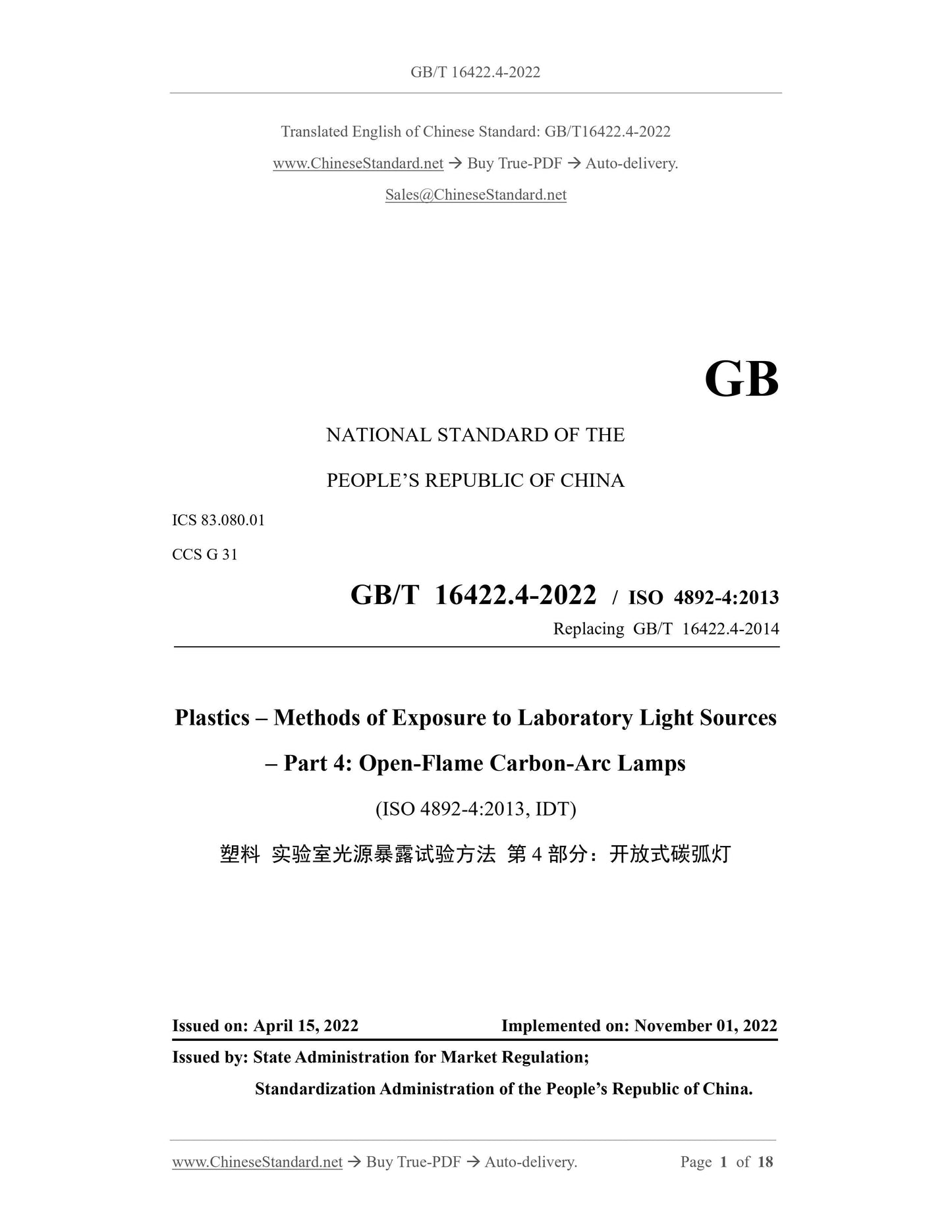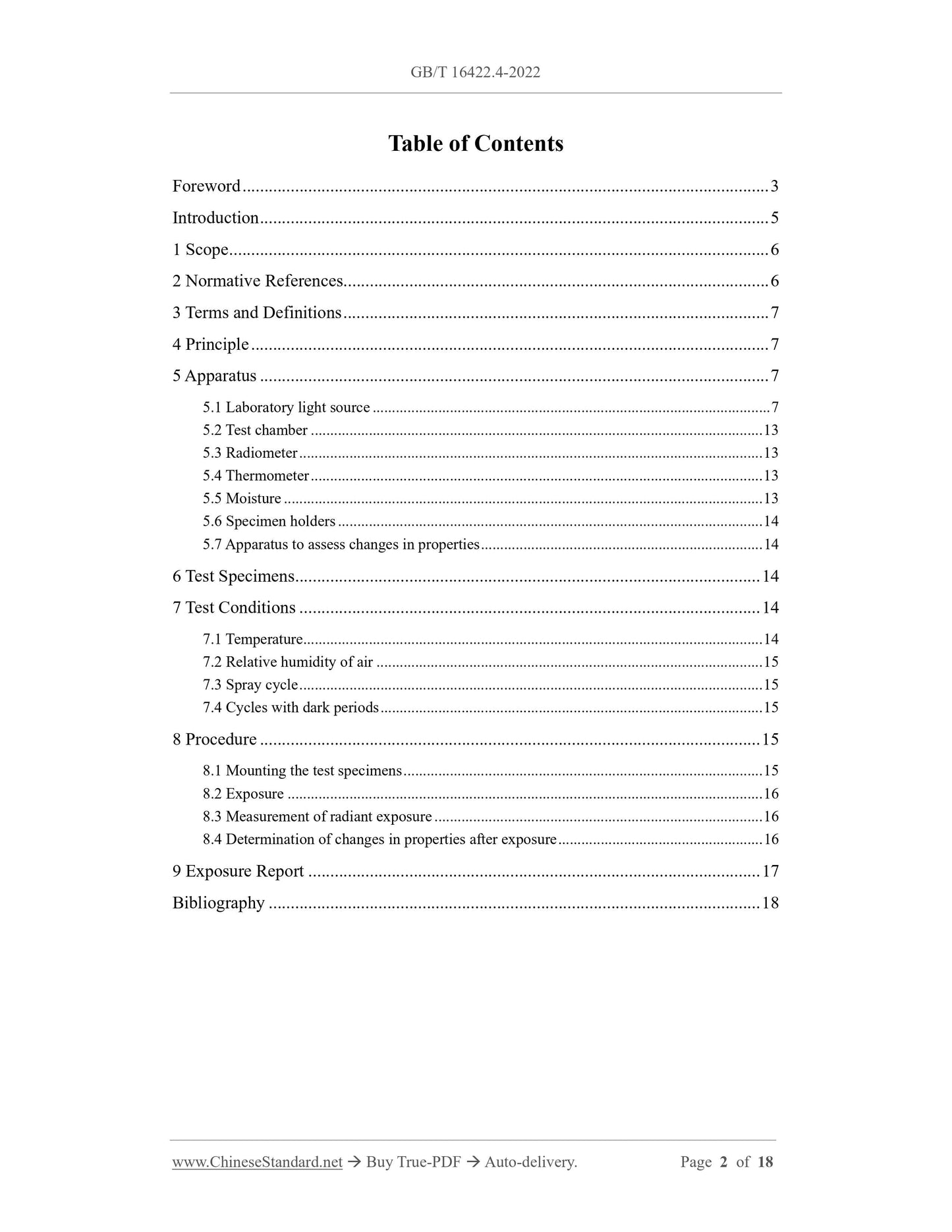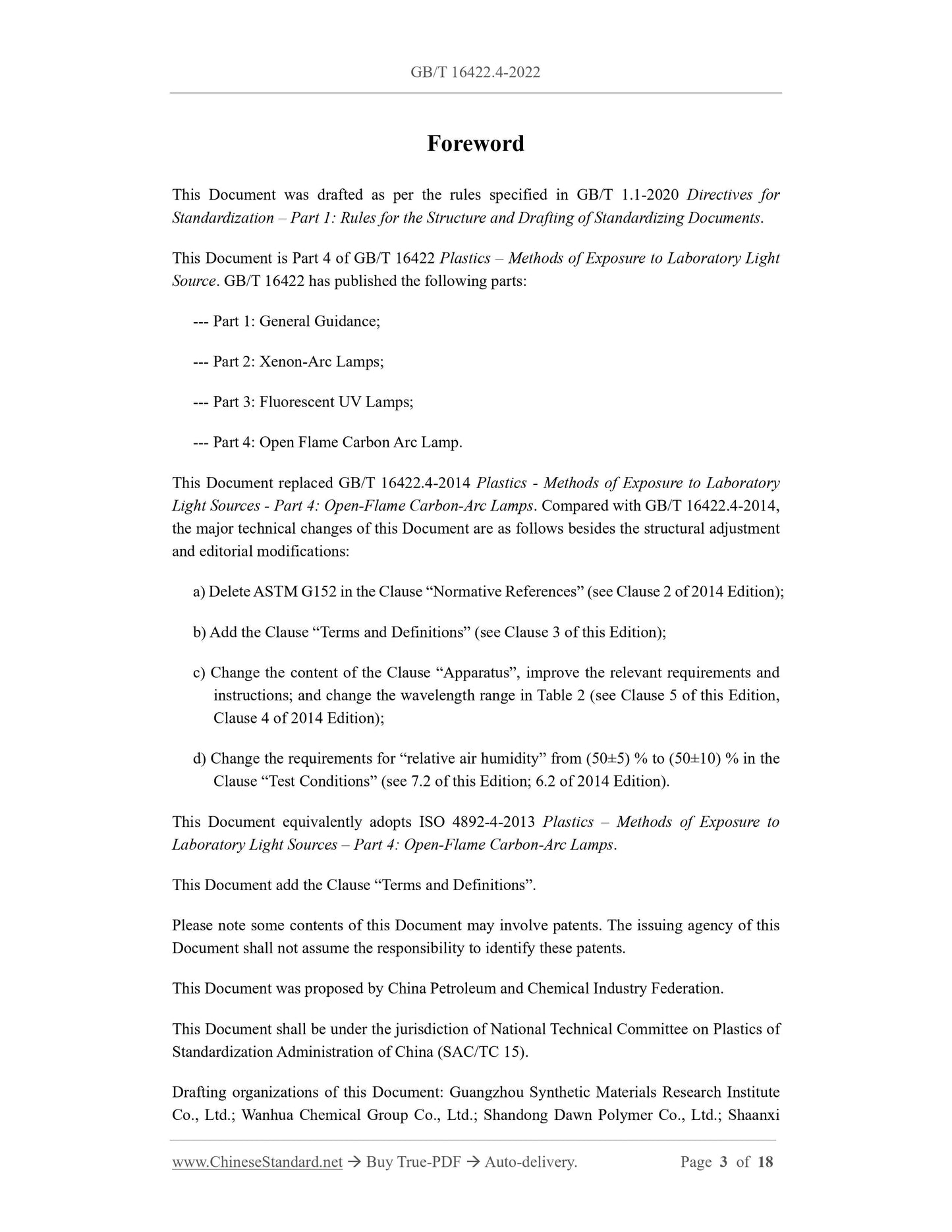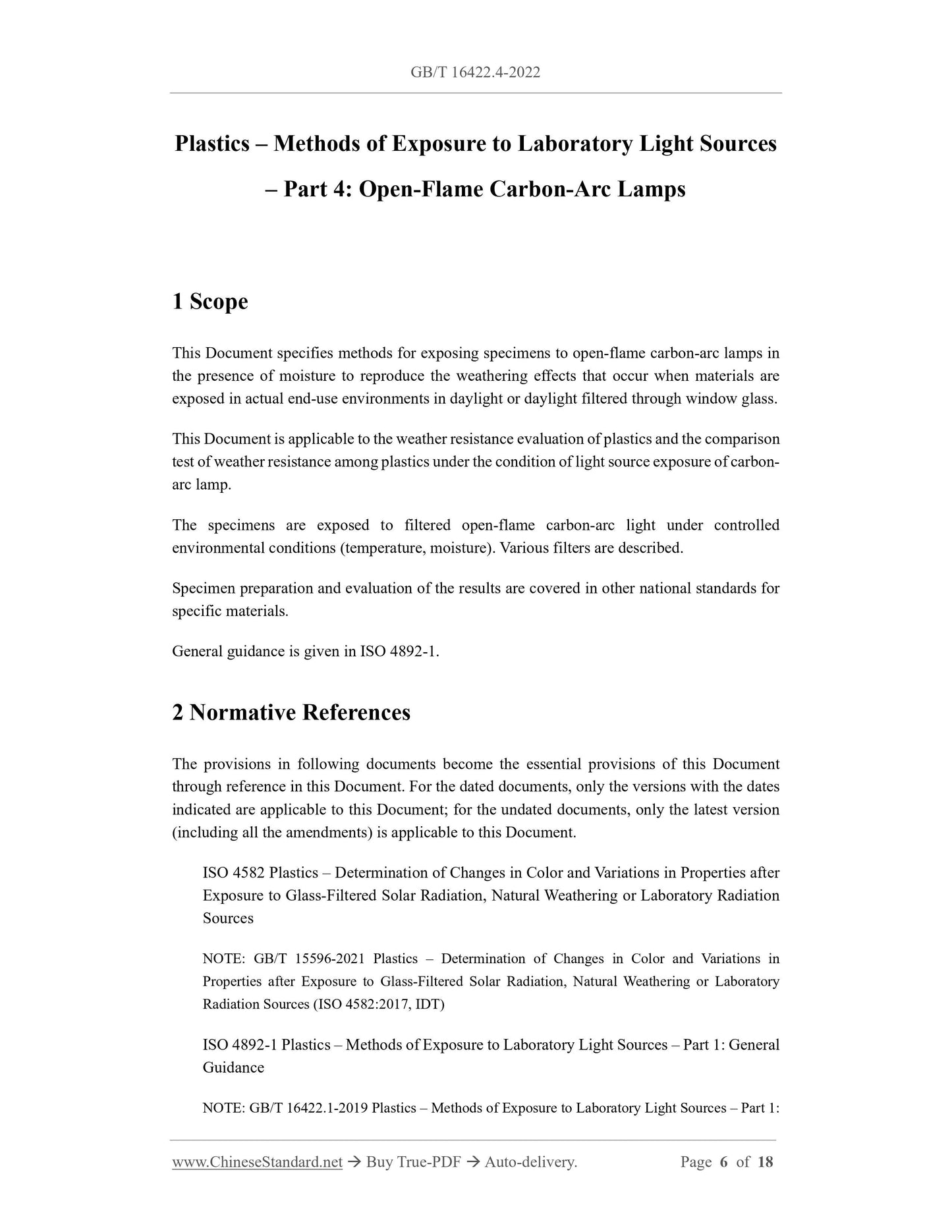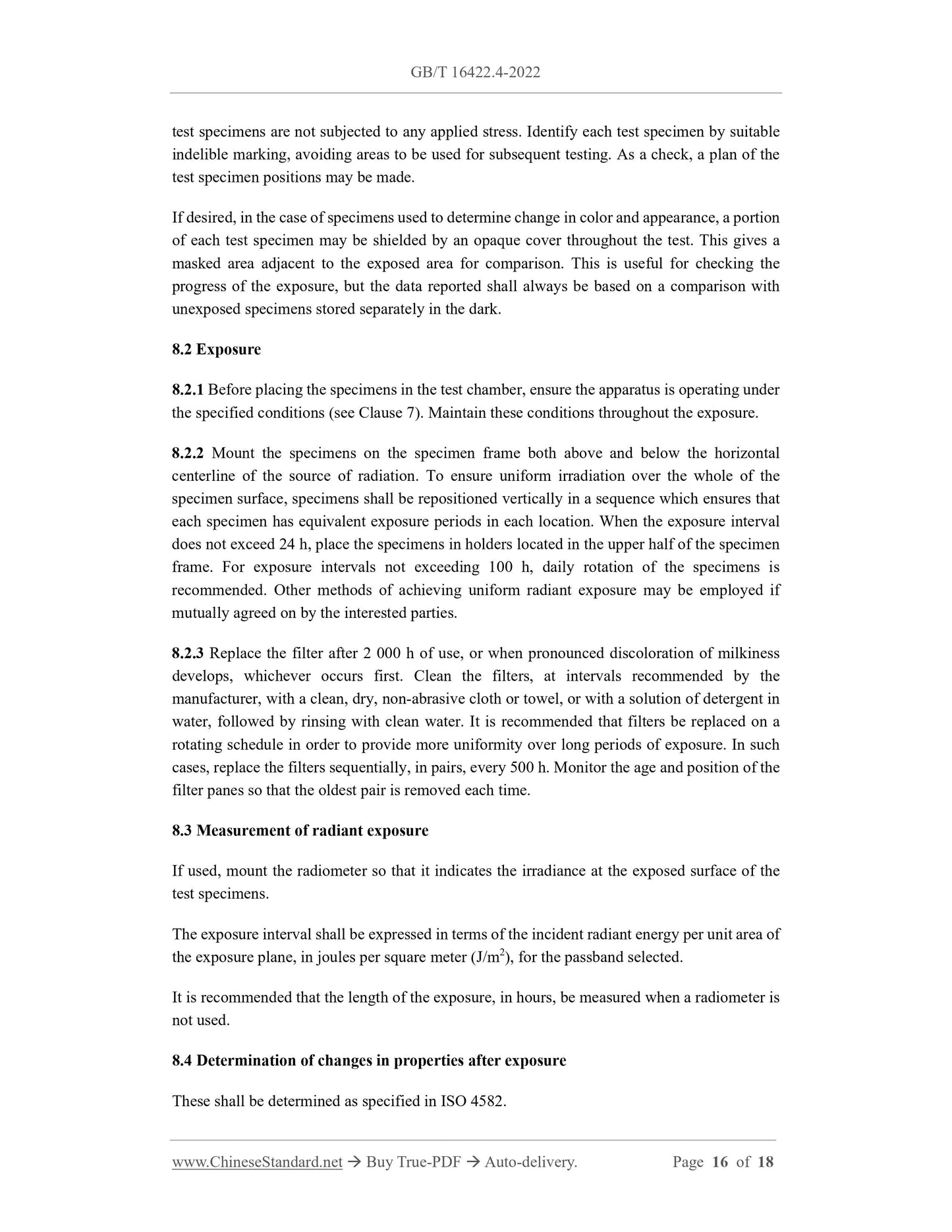1
/
of
5
PayPal, credit cards. Download editable-PDF and invoice in 1 second!
GB/T 16422.4-2022 English PDF (GBT16422.4-2022)
GB/T 16422.4-2022 English PDF (GBT16422.4-2022)
Regular price
$260.00 USD
Regular price
Sale price
$260.00 USD
Unit price
/
per
Shipping calculated at checkout.
Couldn't load pickup availability
Delivery: 3 seconds. Download true-PDF + Invoice.
Get QUOTATION in 1-minute: Click GB/T 16422.4-2022
Historical versions: GB/T 16422.4-2022
Preview True-PDF (Reload/Scroll if blank)
GB/T 16422.4-2022: Plastics -- Methods of exposure to laboratory light sources -- Part 4: Open-flame carbon-arc lamps
GB/T 16422.4-2022
GB
NATIONAL STANDARD OF THE
PEOPLE’S REPUBLIC OF CHINA
ICS 83.080.01
CCS G 31
GB/T 16422.4-2022 / ISO 4892-4:2013
Replacing GB/T 16422.4-2014
Plastics – Methods of Exposure to Laboratory Light Sources
– Part 4: Open-Flame Carbon-Arc Lamps
(ISO 4892-4:2013, IDT)
ISSUED ON: APRIL 15, 2022
IMPLEMENTED ON: NOVEMBER 01, 2022
Issued by: State Administration for Market Regulation;
Standardization Administration of the People’s Republic of China.
Table of Contents
Foreword ... 3
Introduction ... 5
1 Scope ... 6
2 Normative References ... 6
3 Terms and Definitions ... 7
4 Principle ... 7
5 Apparatus ... 7
5.1 Laboratory light source ... 7
5.2 Test chamber ... 13
5.3 Radiometer ... 13
5.4 Thermometer ... 13
5.5 Moisture ... 13
5.6 Specimen holders ... 14
5.7 Apparatus to assess changes in properties ... 14
6 Test Specimens ... 14
7 Test Conditions ... 14
7.1 Temperature ... 14
7.2 Relative humidity of air ... 15
7.3 Spray cycle ... 15
7.4 Cycles with dark periods ... 15
8 Procedure ... 15
8.1 Mounting the test specimens ... 15
8.2 Exposure ... 16
8.3 Measurement of radiant exposure ... 16
8.4 Determination of changes in properties after exposure ... 16
9 Exposure Report ... 17
Bibliography ... 18
Foreword
This Document was drafted as per the rules specified in GB/T 1.1-2020 Directives for
Standardization – Part 1: Rules for the Structure and Drafting of Standardizing Documents.
This Document is Part 4 of GB/T 16422 Plastics – Methods of Exposure to Laboratory Light
Source. GB/T 16422 has published the following parts:
--- Part 1: General Guidance;
--- Part 2: Xenon-Arc Lamps;
--- Part 3: Fluorescent UV Lamps;
--- Part 4: Open Flame Carbon Arc Lamp.
This Document replaced GB/T 16422.4-2014 Plastics - Methods of Exposure to Laboratory
Light Sources - Part 4: Open-Flame Carbon-Arc Lamps. Compared with GB/T 16422.4-2014,
the major technical changes of this Document are as follows besides the structural adjustment
and editorial modifications:
a) Delete ASTM G152 in the Clause “Normative References” (see Clause 2 of 2014 Edition);
b) Add the Clause “Terms and Definitions” (see Clause 3 of this Edition);
c) Change the content of the Clause “Apparatus”, improve the relevant requirements and
instructions; and change the wavelength range in Table 2 (see Clause 5 of this Edition,
Clause 4 of 2014 Edition);
d) Change the requirements for “relative air humidity” from (50±5) % to (50±10) % in the
Clause “Test Conditions” (see 7.2 of this Edition; 6.2 of 2014 Edition).
This Document equivalently adopts ISO 4892-4-2013 Plastics – Methods of Exposure to
Laboratory Light Sources – Part 4: Open-Flame Carbon-Arc Lamps.
This Document add the Clause “Terms and Definitions”.
Please note some contents of this Document may involve patents. The issuing agency of this
Document shall not assume the responsibility to identify these patents.
This Document was proposed by China Petroleum and Chemical Industry Federation.
This Document shall be under the jurisdiction of National Technical Committee on Plastics of
Standardization Administration of China (SAC/TC 15).
Drafting organizations of this Document: Guangzhou Synthetic Materials Research Institute
Co., Ltd.; Wanhua Chemical Group Co., Ltd.; Shandong Dawn Polymer Co., Ltd.; Shaanxi
Plastics – Methods of Exposure to Laboratory Light Sources
– Part 4: Open-Flame Carbon-Arc Lamps
1 Scope
This Document specifies methods for exposing specimens to open-flame carbon-arc lamps in
the presence of moisture to reproduce the weathering effects that occur when materials are
exposed in actual end-use environments in daylight or daylight filtered through window glass.
This Document is applicable to the weather resistance evaluation of plastics and the comparison
test of weather resistance among plastics under the condition of light source exposure of carbon-
arc lamp.
The specimens are exposed to filtered open-flame carbon-arc light under controlled
environmental conditions (temperature, moisture). Various filters are described.
Specimen preparation and evaluation of the results are covered in other national standards for
specific materials.
General guidance is given in ISO 4892-1.
2 Normative References
The provisions in following documents become the essential provisions of this Document
through reference in this Document. For the dated documents, only the versions with the dates
indicated are applicable to this Document; for the undated documents, only the latest version
(including all the amendments) is applicable to this Document.
ISO 4582 Plastics – Determination of Changes in Color and Variations in Properties after
Exposure to Glass-Filtered Solar Radiation, Natural Weathering or Laboratory Radiation
Sources
NOTE: GB/T 15596-2021 Plastics – Determination of Changes in Color and Variations in
Properties after Exposure to Glass-Filtered Solar Radiation, Natural Weathering or Laboratory
Radiation Sources (ISO 4582:2017, IDT)
ISO 4892-1 Plastics – Methods of Exposure to Laboratory Light Sources – Part 1: General
Guidance
NOTE: GB/T 16422.1-2019 Plastics – Methods of Exposure to Laboratory Light Sources – Part 1:
test specimens are not subjected to any applied stress. Identify each test specimen by suitable
indelible marking, avoiding areas to be used for subsequent testing. As a check, a plan of the
test specimen positions may be made.
If desired, in the case of specimens used to determine change in color and appearance, a portion
of each test specimen may be shielded by an opaque cover throughout the test. This gives a
masked area adjacent to the exposed area for comparison. This is useful for checking the
progress of the exposure, but the data reported shall always be based on a comparison with
unexposed specimens stored separately in the dark.
8.2 Exposure
8.2.1 Before placing the specimens in the test chamber, ensure the apparatus is operating under
the specified conditions (see Clause 7). Maintain these conditions throughout the exposure.
8.2.2 Mount the specimens on the specimen frame both above and below the horizontal
centerline of the source of radiation. To ensure uniform irradiation over the whole of the
specimen surface, specimens shall be repositioned vertically in a sequence which ensures that
each specimen has equivalent exposure periods in each location. When the exposure interval
does not exceed 24 h, place the specimens in holders located in the upper half of the specimen
frame. For exposure intervals not exceeding 100 h, daily rotation of the specimens is
recommended. Other methods of achieving uniform radiant exposure may be employed if
mutually agreed on by the interested parties.
8.2.3 Replace the filter after 2 000 h of use, or when pronounced discoloration of milkiness
develops, whichever occurs first. Clean the filters, at intervals recommended by the
manufacturer, with a clean, dry, non-abrasive cloth or towel, or with a solution of detergent in
water, followed by rinsing with clean water. It is recommended that filters be replaced on a
rotating schedule in order to provide more uniformity over long periods of exposure. In such
cases, replace the filters sequentially, in pairs, every 500 h. Monitor the age and position of the
filter panes so that the oldest pair is removed each time.
8.3 Measurement of radiant exposure
If used, mount the radiometer so that it indicates the i...
Get QUOTATION in 1-minute: Click GB/T 16422.4-2022
Historical versions: GB/T 16422.4-2022
Preview True-PDF (Reload/Scroll if blank)
GB/T 16422.4-2022: Plastics -- Methods of exposure to laboratory light sources -- Part 4: Open-flame carbon-arc lamps
GB/T 16422.4-2022
GB
NATIONAL STANDARD OF THE
PEOPLE’S REPUBLIC OF CHINA
ICS 83.080.01
CCS G 31
GB/T 16422.4-2022 / ISO 4892-4:2013
Replacing GB/T 16422.4-2014
Plastics – Methods of Exposure to Laboratory Light Sources
– Part 4: Open-Flame Carbon-Arc Lamps
(ISO 4892-4:2013, IDT)
ISSUED ON: APRIL 15, 2022
IMPLEMENTED ON: NOVEMBER 01, 2022
Issued by: State Administration for Market Regulation;
Standardization Administration of the People’s Republic of China.
Table of Contents
Foreword ... 3
Introduction ... 5
1 Scope ... 6
2 Normative References ... 6
3 Terms and Definitions ... 7
4 Principle ... 7
5 Apparatus ... 7
5.1 Laboratory light source ... 7
5.2 Test chamber ... 13
5.3 Radiometer ... 13
5.4 Thermometer ... 13
5.5 Moisture ... 13
5.6 Specimen holders ... 14
5.7 Apparatus to assess changes in properties ... 14
6 Test Specimens ... 14
7 Test Conditions ... 14
7.1 Temperature ... 14
7.2 Relative humidity of air ... 15
7.3 Spray cycle ... 15
7.4 Cycles with dark periods ... 15
8 Procedure ... 15
8.1 Mounting the test specimens ... 15
8.2 Exposure ... 16
8.3 Measurement of radiant exposure ... 16
8.4 Determination of changes in properties after exposure ... 16
9 Exposure Report ... 17
Bibliography ... 18
Foreword
This Document was drafted as per the rules specified in GB/T 1.1-2020 Directives for
Standardization – Part 1: Rules for the Structure and Drafting of Standardizing Documents.
This Document is Part 4 of GB/T 16422 Plastics – Methods of Exposure to Laboratory Light
Source. GB/T 16422 has published the following parts:
--- Part 1: General Guidance;
--- Part 2: Xenon-Arc Lamps;
--- Part 3: Fluorescent UV Lamps;
--- Part 4: Open Flame Carbon Arc Lamp.
This Document replaced GB/T 16422.4-2014 Plastics - Methods of Exposure to Laboratory
Light Sources - Part 4: Open-Flame Carbon-Arc Lamps. Compared with GB/T 16422.4-2014,
the major technical changes of this Document are as follows besides the structural adjustment
and editorial modifications:
a) Delete ASTM G152 in the Clause “Normative References” (see Clause 2 of 2014 Edition);
b) Add the Clause “Terms and Definitions” (see Clause 3 of this Edition);
c) Change the content of the Clause “Apparatus”, improve the relevant requirements and
instructions; and change the wavelength range in Table 2 (see Clause 5 of this Edition,
Clause 4 of 2014 Edition);
d) Change the requirements for “relative air humidity” from (50±5) % to (50±10) % in the
Clause “Test Conditions” (see 7.2 of this Edition; 6.2 of 2014 Edition).
This Document equivalently adopts ISO 4892-4-2013 Plastics – Methods of Exposure to
Laboratory Light Sources – Part 4: Open-Flame Carbon-Arc Lamps.
This Document add the Clause “Terms and Definitions”.
Please note some contents of this Document may involve patents. The issuing agency of this
Document shall not assume the responsibility to identify these patents.
This Document was proposed by China Petroleum and Chemical Industry Federation.
This Document shall be under the jurisdiction of National Technical Committee on Plastics of
Standardization Administration of China (SAC/TC 15).
Drafting organizations of this Document: Guangzhou Synthetic Materials Research Institute
Co., Ltd.; Wanhua Chemical Group Co., Ltd.; Shandong Dawn Polymer Co., Ltd.; Shaanxi
Plastics – Methods of Exposure to Laboratory Light Sources
– Part 4: Open-Flame Carbon-Arc Lamps
1 Scope
This Document specifies methods for exposing specimens to open-flame carbon-arc lamps in
the presence of moisture to reproduce the weathering effects that occur when materials are
exposed in actual end-use environments in daylight or daylight filtered through window glass.
This Document is applicable to the weather resistance evaluation of plastics and the comparison
test of weather resistance among plastics under the condition of light source exposure of carbon-
arc lamp.
The specimens are exposed to filtered open-flame carbon-arc light under controlled
environmental conditions (temperature, moisture). Various filters are described.
Specimen preparation and evaluation of the results are covered in other national standards for
specific materials.
General guidance is given in ISO 4892-1.
2 Normative References
The provisions in following documents become the essential provisions of this Document
through reference in this Document. For the dated documents, only the versions with the dates
indicated are applicable to this Document; for the undated documents, only the latest version
(including all the amendments) is applicable to this Document.
ISO 4582 Plastics – Determination of Changes in Color and Variations in Properties after
Exposure to Glass-Filtered Solar Radiation, Natural Weathering or Laboratory Radiation
Sources
NOTE: GB/T 15596-2021 Plastics – Determination of Changes in Color and Variations in
Properties after Exposure to Glass-Filtered Solar Radiation, Natural Weathering or Laboratory
Radiation Sources (ISO 4582:2017, IDT)
ISO 4892-1 Plastics – Methods of Exposure to Laboratory Light Sources – Part 1: General
Guidance
NOTE: GB/T 16422.1-2019 Plastics – Methods of Exposure to Laboratory Light Sources – Part 1:
test specimens are not subjected to any applied stress. Identify each test specimen by suitable
indelible marking, avoiding areas to be used for subsequent testing. As a check, a plan of the
test specimen positions may be made.
If desired, in the case of specimens used to determine change in color and appearance, a portion
of each test specimen may be shielded by an opaque cover throughout the test. This gives a
masked area adjacent to the exposed area for comparison. This is useful for checking the
progress of the exposure, but the data reported shall always be based on a comparison with
unexposed specimens stored separately in the dark.
8.2 Exposure
8.2.1 Before placing the specimens in the test chamber, ensure the apparatus is operating under
the specified conditions (see Clause 7). Maintain these conditions throughout the exposure.
8.2.2 Mount the specimens on the specimen frame both above and below the horizontal
centerline of the source of radiation. To ensure uniform irradiation over the whole of the
specimen surface, specimens shall be repositioned vertically in a sequence which ensures that
each specimen has equivalent exposure periods in each location. When the exposure interval
does not exceed 24 h, place the specimens in holders located in the upper half of the specimen
frame. For exposure intervals not exceeding 100 h, daily rotation of the specimens is
recommended. Other methods of achieving uniform radiant exposure may be employed if
mutually agreed on by the interested parties.
8.2.3 Replace the filter after 2 000 h of use, or when pronounced discoloration of milkiness
develops, whichever occurs first. Clean the filters, at intervals recommended by the
manufacturer, with a clean, dry, non-abrasive cloth or towel, or with a solution of detergent in
water, followed by rinsing with clean water. It is recommended that filters be replaced on a
rotating schedule in order to provide more uniformity over long periods of exposure. In such
cases, replace the filters sequentially, in pairs, every 500 h. Monitor the age and position of the
filter panes so that the oldest pair is removed each time.
8.3 Measurement of radiant exposure
If used, mount the radiometer so that it indicates the i...
Share
